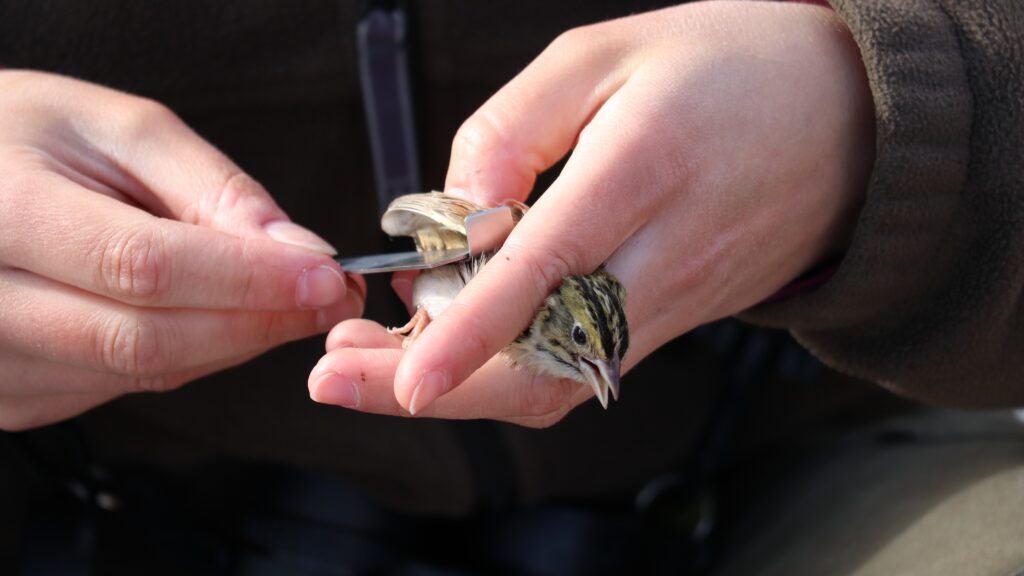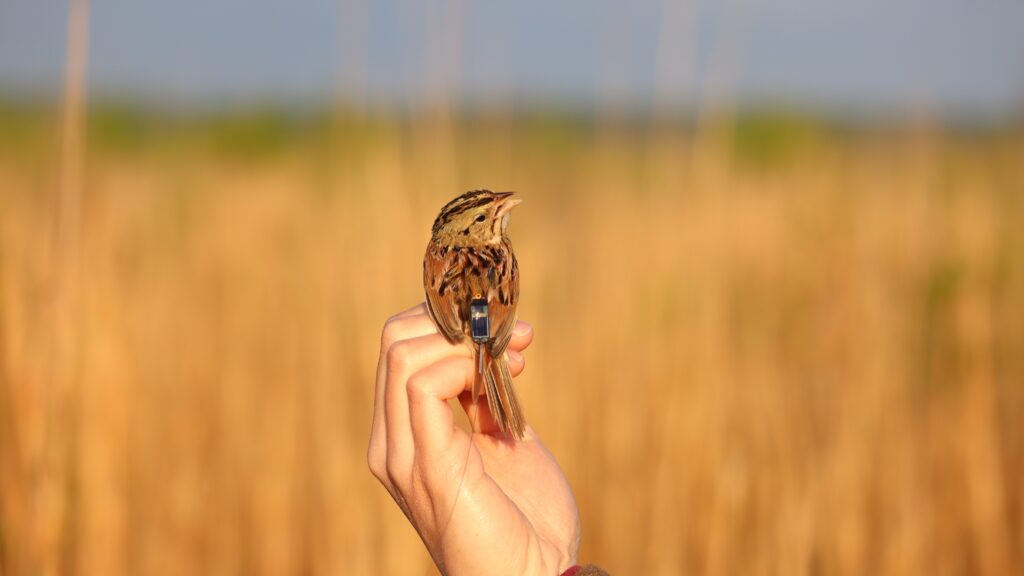Global Change Fellow Emily Nastase is Drawing Attention to the Threatened Henslow’s Sparrow

Henslow’s sparrow (Centronyx henslowii) populations have been declining since the early 20th century, but a population in North Carolina may help researchers understand how managers can help preserve this once prominent species.
Emily Nastase is a PhD student in the department of Applied Ecology at NC State and a 2022–23 Global Change Fellow. Nastase’s research focuses on the ecology, distribution, and population genetics of the Henslow’s sparrow at the North Carolina Wildlife Resources Commission’s Voice of America Game Land in Washington, NC.
To do this, Nastase, along with field technician Abbie Valine, captures and tags sparrows with radio transmitters, collects blood samples, and tracks the location of their territories and nesting sites.
They use mist nets to catch male Henslow’s; once caught, Nastase puts a silver USGS band with an identification number on the bird’s leg so they can be identified in the future. They then measure its wing length, determine its age and how ready they are to breed, do a check for ticks and general health, and finally weigh them. If the bird is heavy enough it will be fitted with a radio tag and a unique color band combination so it can be identified from a distance. Nastase uses tags that are solar powered and are expected to last the lifetime of the bird.

Henslow’s sparrows have a unique history in the United States and while they are not currently listed as endangered, they are considered threatened.
“In the late 1800s, there was an eastern and a western subspecies of the Henslow’s sparrow,” says Nastase. “Their breeding extents eventually merged as a result of humans clearcutting forested habitats. But ever since then, populations have been declining. A lot of habitats that used to be part of the breeding range for the eastern subspecies are now unoccupied. So either they’ve been extirpated from so many of their original breeding sites or the eastern subspecies is extinct.”
While Henslow’s sparrows are known to winter in Gulf Coast states, this site in North Carolina is the only known large breeding population on the east coast. Based on her research, Nastase has a couple of theories as to where these birds might have come from.
“One theory is that these birds might be a remnant of that eastern subspecies. It’s also possible that maybe they were all from the same original subspecies like that western group,” says Nastase. “But maybe there’s some divergence happening now because these birds do have a lot of site fidelity, so the breeding and genetics are going to stay pretty close in this region.”

Because sites in the historic breeding habitat range are declining, especially on the east coast, researchers and resource managers want to understand how best to conserve these habitats into the future.
“Climate change is altering the availability of these breeding sites,” adds Nastase. “Grasslands like this are really hard to find now. This is the only one I know of in eastern North Carolina that’s a fairly low-lying, wet meadow structure, but that’s large enough to accommodate a species like the Henslow. Henslow’s are considered “loosely colonial”, meaning that they like to nest near other Henslow’s, so they need adequate space to fill multiple breeding territories.”
The North Carolina Wildlife Resources Commission manages the area to maintain this unique grassland structure. Every year different parts of the site are burned in a rotation to keep woody vegetation at bay.
“Climate change is really reducing the availability of these types of habitats and it’s changing the burn regime, so even if there were grasslands that used to persist in these areas, wildfires either don’t happen or they don’t happen at the right time to maintain this type of habitat,” adds Nastase.
This future conditions scenario is the subject of Nastase’s final question for the project, which will look at how future climate conditions are going to change burning opportunities at the site. This will help managers determine when and how to burn.
“To keep this grassland habitat you want to burn it hot and at the right time of year to kill off the woody vegetation,” says Nastase. “But you can’t burn it too close to the Henslow’s Sparrow breeding cycle because they nest in the summer, so you’re constrained on two sides. You have to find the perfect window of opportunity to make that happen and unfortunately climate change is probably going to cause a mismatch in how they currently manage here versus the species breeding phenology.”
This research will help resource managers conserve and restore Henslow’s sparrow populations in North Carolina and potentially provide an example for future projects in the Southeast.
- Categories:
